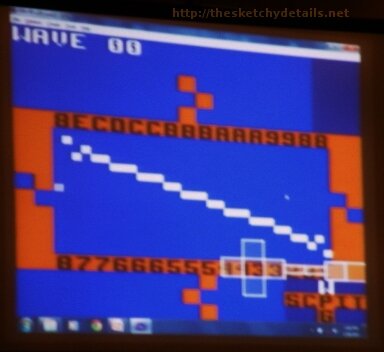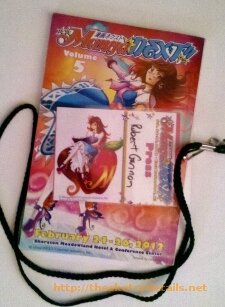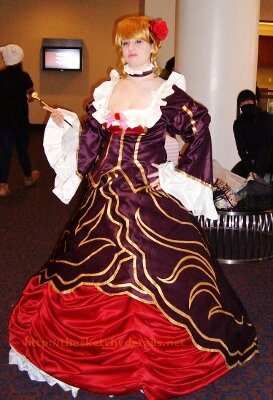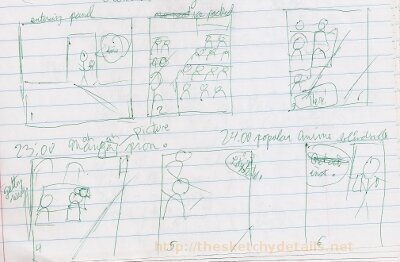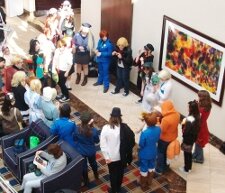At the MangaNEXT convention, part of the team behind Underbelly ran a panel about bad anime. Specifically, the panel became a discussion between everyone in the room about what, exactly, makes a potentially good anime series go bad in translation.
The discussion routinely brought out three core issues found in bad anime. All involve translating material. While a poor dub and questionable localization can make a series go wrong in the international market, a poor translation from page (manga) to screen can be just as damaging.
The American parallel is simple. Think of comic book movies. How often do we really get solid adaptations of a story telling medium meant to be digested in 20 to 24 page installments? Even if you’re being generous, it’s hard to argue that there’s anywhere near a 50 percent success rate. For every Captain America: The First Avenger and The Dark Knight, there’s a Ghost Rider: Spirit of Vengeance or Green Lantern. We’d be lucky at this point if it balanced out to one good comic book film for every bad comic book film.
Now imagine that issue happening in a print medium where new stories are coming out every week. The creators of manga are on a very tight production schedule to get their stories to market on time. This alone can cause inconsistencies or problems with the story as a larger work.
Take those individual stories and adapt them, week for week, into a TV series. Chances are, you can’t animate exactly what happens on the page. Maybe there isn’t enough material in any one issue to fill 22 minutes of TV time. Maybe the action is too extreme or happens in the background so you can’t focus on those subjects without major changes.
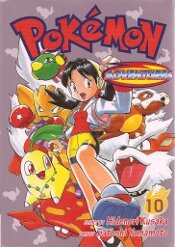
There are over 400 chapters (stories) in the Pokemon manga and over 700 episodes of the anime.
These filler arcs can be the most problematic part of anime. The creators of the TV show either have to make stuff up or revisit old topics to keep the series going. This can mean new characters introduced who have no bearing on the plot or episodes that basically retell the same story with slightly different circumstances. Did two characters fight on a mountain? Great. They can have the same fight by the beach or in the woods with slightly different dialogue and actions.
The issue of adaptation is not a novel one for anime. Where the concept of bad anime really gets its common talking points is in the international dubs. US production companies buy the rights to air popular anime programs on TV. At that point, you quickly know if a story will sink or swim in America.
The problem with translating for America is that animation is still mainly viewed as a medium for children. Cartoons are for kids. If an anime has excessive violence, bad language, or adult content, it’s routinely altered to appeal to a much younger demographic.

You won't see this in a 4Kids dub.
4Kids, the company that previously brought Pokemon and Yu-gi-oh! to America, thought they struck gold with One Piece. They dubbed the series and were eager to premiere it in the US. They also heavily altered the animation, rewrote characters, eliminated important plot points, and acted like the violent war between pirates for domination was a play date at the park.
4Kids was not content to just tone down the violence. Many companies have done that for the US market. They mop out the blood and change death or the afterlife to an alternate dimension.* With the changes 4Kids made, they might as well have animated a brand new show.
Guns were either replaced with less violent weapons or painted to resemble water guns. Any smoking–cigarette or cigar–was wiped away, often leaving a mysterious cloud surrounding the characters. Costumes were redrawn to be less revealing. Blood is non-existent. Alcohol is changed to resemble water or fruit juice. Non-central characters doing violent things are erased completely from the frame. Death becomes jail and any plot involving revenge–a big part of the series–suffers for no longer having a real motivation.
4Kids is one of the rare examples where the meddling became so bad that a company lost the rights to distribute a show internationally. Funimation was left to pick up the pieces and redub One Piece for an American audience. The differences in approach could not be anymore drastic. The new dubs of One Piece actually make sense and restore the original stakes of the series.
Aside from translating and altering content to meet US standards–real or imagined, anime programs are at the mercy of localization issues. For some odd reason, the standard method for translating anime to the US is to change everything to America. Rice balls become donuts. Common gestures are given parallels to American culture and characters say things that go completely against what’s happening onscreen just to sound more local.
The problem is that manga and anime, as media, are deeply rooted in Japanese culture. You take Japan out of the equation and the stories already start to suffer. No, we know that the carefully prepared sushi in the restaurant is not a table full of cheeseburgers. The characters are clearly wearing kimonos, not pajamas, and school uniforms are not the latest style trend that an entire school is wearing by chance. The more the series are shifted away from the daily life and culture of Japan, the more they start to strain their credibility.
Then there is the most tangible aspect of bad anime: the dubbing. Just be thankful at this point that foreign films are available with subtitles if they’re live action. Animation is almost a lost cause if you want to hear the original voices on TV or in theaters.
Dubbing is a tricky prospect because animation on mouth movements are done to match the voice actors. That means, for an effective dub, the words in English have to match the lip movements of the animation cued up to Japanese dialogue.
Underbelly took a good look at this topic last year. The video is NSFW, but it goes into how difficult it is to fill time. These problems can be caused by idioms that don’t translate into English, short phrases that don’t translate nearly as briefly in English, and long phrases that can be handled with only a few words in a dub. And don’t forget how often voice overs are added to explain the animated action onscreen. As in, narration just to add voices to the mix.
Adapting any material from one medium to another is going to pose challenges. Anime just suffers from a lot of meddling by the time it reaches an international audience. Strange things are bound to slip through. It goes from a comic to a TV show, then gets altered and rewritten to appeal to international audiences, followed by dubbing to make the anime sound as domestic as possible wherever you are in the world. The product that reaches America is about as far removed from the original idea as it can be.
When handled properly, a dubbed anime can be an enjoyable thing to watch. That’s rarely the case, especially when the series is targeted toward a younger audience. I know not everyone likes subtitles in anime. I prefer them just so I can hear the original unaltered audio. I may not be able to understand Japanese, but I can understand tone and inflection in a performance.
*That doesn’t make those changes right, but it’s standard practice at this point.
Thoughts? Any other examples? Love to hear them.



